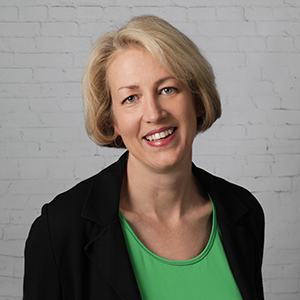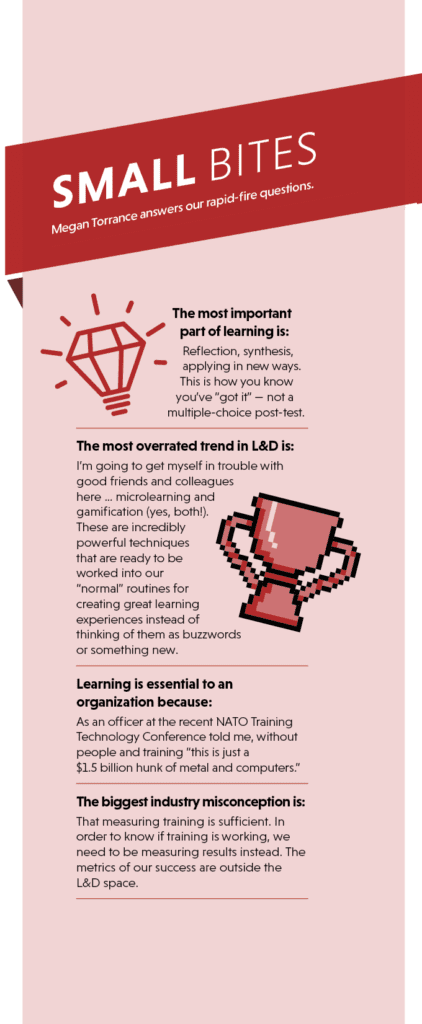 How did you start your career in learning?
How did you start your career in learning?
I snuck up on it! In college, I had the amazing fortune to work in an HR department during the early days of the Americans with Disabilities Act. I was hired as a graphic designer, but soon was writing content for their training implementation statewide. After getting a bachelor’s in communication and an MBA, I joined Andersen Consulting (now Accenture), learned Authorware (an early e-learning authoring tool) and how to write training guides … then was never staffed on a project where that was my role. I was managing projects for large shared service center implementations and working my way through the back office functions that nearly every business shares: payroll, personnel admin, payables, receivables, billing, reporting, etc., and finally ended up helping UnitedHealth Group with their learning management system implementation. It was their first enterprise LMS and their software company’s first LMS, too. Once we got that system up and running, I worked for the software company LearnShare with their new LMS implementations and training for a few years. Finally in 2006, one of those clients asked, “Can you build the training that goes into my new LMS?” And that’s when my work in custom course development really got its start.
 What attracted you to L&D?
What attracted you to L&D?
L&D has such an amazing window into the rest of the organization. We get to help all the other functions perform better. I like to think that, when done well, L&D helps reduce organizational stress loads because we are often providing the keys to competence that help people do their jobs well and confidently. Along the way, we’re combining learning science, technology, facilitation, visual design, experience design and project management to make it all happen.
In my role as a vendor in L&D, I have an incredible opportunity to learn because I’m constantly working with a different client’s material. Over the years, I’ve learned how to make spray-dried vinegar powder, cereal pieces, how to use all sorts of software, how to identify a stroke and what do to when you suspect a concussion (useful life skills!), how to work with advertising teams, all about recreational vehicle parts and accessories, both industrial chemistry and food chemistry, how to talk about healthy food choices with preschoolers, clinical research practices, amusement park safety, in-home senior care — the list goes on.
Your favorite learning technology trend in 2019?
Oh, there’s so much going on — this is a really fun time to be in this industry. But if I had to choose, I am loving how we’re really seeing traction on learning analytics. We’re seeing a wider adoption of data-driven decision-making in an industry in which we are often not known for our deep evaluation ethos. More and more organizations are using interoperable data (xAPI) to drive those analytics, meaning that we’ll eventually have the interoperability that Shareable Content Object Reference Models gave the e-learning world across a wider variety of learning and performance activities.
This means that L&D professionals are broadening their tool set — either by learning the skills themselves or expanding their purview and their teams to include more technology, more data science and more analytics. And it means that organizations can see the L&D function in a new and more powerful light as we are better able to connect what we do to business outcomes.
What lessons helped you get where you are?
A couple of years ago, consultant Kevin Suboski told me that “business is a network of relationships among people” — it’s so true! And a career is made up of so many lessons from those people, starting with my first boss’s advice to dry my hair before I come to work. Lately I’ve been thinking of the advice of a few formal and informal mentors whose insights and examples are particularly relevant to me now. Mel Drumm at the Ann Arbor Hands-On Museum combines insatiable curiosity with genuine appreciation for the contributions of others — you can’t help but be excited to work with him. Business finance adviser Deborah Christein told me once that saying “no” is just as important as saying “yes” to things. Rob Houck at LearnShare sets an example for listening and hearing someone out before jumping to solutions. That patience is something I try to channel whenever I’m in a tough spot. And my tough-as-nails mother is the one who told me it’s OK to ask for help — that some periods of your life are for giving and others are for receiving.
Your most important piece of career advice?
This may sound a bit contrarian: Pace yourself. On the one hand, by all means jump into your career with gusto. Say yes. Take on stretch projects. Learn something new. Work hard and long at something you’re passionate about doing right. But also take time to recharge. There are periods in life when steady-as-she-goes is completely fine. There’s a technique in hiking called a “rest step,” where you slow your cadence and rest your muscles while keeping moving. This is on my mind a lot lately.















